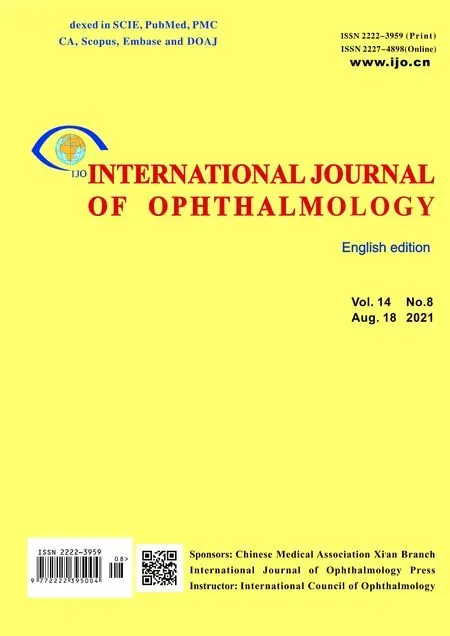Bietti’s crystalline dystrophy in an African American patient: an unusual racial demographic for a condition more common in individuals of East Asian descent
Virang Kumar, Vikram Brar, Jordyn Prell, Ann Jewell, Natario Couser,,4
1Virginia Commonwealth University School of Medicine,Richmond, VA 23298, USA
2Department of Ophthalmology, Virginia Commonwealth University School of Medicine, Richmond, VA 23298, USA
3Department of Human and Molecular Genetics, Virginia Commonwealth University School of Medicine, Richmond,VA 23298, USA
4Department of Pediatrics, Virginia Commonwealth University School of Medicine, Richmond, VA 23298, USA
Dear Editor,
The study outlining the manifestations of Bietti’s crystalline dystrophy (BCD) in five Chinese patients offered insights into common disease-causing variants associated with Chinese patients as well as a novel mutation[1].This genetic condition is commonly reported among East Asian populations and to some extent Mediterranean populations[2].The purpose of this letter is to report the clinical and recently obtained molecular genetic testing characteristics in a patient who is African American, a racial demographic not typically associated with this disease.
A 76-year-old African American female previously reported with BCD based on her clinical presentation, underwent genetic testing for molecular confirmation in July 2019;this report details the molecular testing results[3]. She had an inherited retinal dystrophies gene sequencing and deletion/duplication panel performed which included 248 genes. This testing revealed a pathogenic variant and a variant of uncertain significance inCYP4V2,the gene associated with autosomal recessive BCD.
The testing also showed mutations in three other genes:CEP41:c.431G>A (p.Ser144Asn),IFT172:c.2158C>T(p.Arg720Cys), andRBP3:c.1400C>T (p.Pro467Leu); all of these were classified as variants of uncertain significance.None of these three variants are suspected to be a part of BCD nor relevant for this patient’s clinical phenotype.
The first variant inCYP4V2is a heterozygous deletion encompassing exon 1, including the initiator codon, which is classified as pathogenic. This variant is expected to result in an absent or disrupted protein product and has not been previously reported in the literature. However, variants that result in loss of function inCYP4V2are known to be pathogenic; thus, this variant has been classified as such[4-5].
The other variant identified is a heterozygous missense variant,CYP4V2c.1523G>Α (p.Αrg508His), classified as a variant of uncertain significance. This change results in a substitution of arginine for histidine at codon 508 of the CYP4V2 protein.The arginine residue in this position is highly conserved and there is a small physiochemical difference between arginine and histidine. This variant is present in population databases(rs119103284, ExAC 0.01%) and prediction algorithm results for this change are either unavailable or do not agree on the potential impact. Additionally, this variant has been observed in individuals affected with clinical features of BCD and is possibly predicted to have a functional impact on the protein[4].It has been reported in ClinVar as pathogenic for this study[6].Given the conflicting evidence, this missense variant was classified as a variant of uncertain significance.
Of note, the test could not determine if theCYP4V2variants are incisortrans. Additional informative relatives were not available for testing at this time. Based on her clinical presentation, it is most likely that both mutations identified are disease causing and one is on each copy of the gene.
The c.1523G>A variant has been reported in a patient of European descent, possibly suggesting our reported patient may have European heritage, or that the patient of European descent may have African heritage, although more patients of both populations would be required to understand this relationship[2,4]. This differs from common mutations in Chinese patients, which includes the c.802-8_810del17insGC and c.1091-21>G mutations, as well as c.992A>C[1-2].

Figure 1 Fundoscopic exam showing bilateral presence of yellow-white retinal deposits and RPE atrophy in the mid-peripheral fundus.
Upon her last ophthalmic examination, her best corrected visual acuities were 20/30-2 and 20/25-1. There was no evidence of corneal deposits on slit-lamp evaluation of the anterior segment. Dilated fundus examination was stable in comparison to previous exams, with numerous yellowwhite retinal deposits and multifocal areas of retinal pigment epithelium (RPE) atrophy in the mid-peripheral fundus of both eyes (Figure 1).
Likewise, in the Chinese patients, corneal crystals were absent,while RPE atrophy and yellow crystals in the fundi were present in all five patients. This pattern of findings, referred to as a pure retinal form, has been shown to be more common among Asian populations rather than Caucasian populations[1].Thus, more data on the phenotypes of African American patients with BCD could further elucidate the presence or absence of this pattern.
In conclusion, this letter compares the presentation of BCD in a patient from a rarer population to those of a commonly studied population. Such a comparison can be useful when distinguishing different genotypic and phenotypic patterns among different populations, especially as more cases are reported. Ultimately, such efforts can allow for more targeted and individualized therapies to be developed.
ACKNOWLEDGEMENTS
Conflicts of Interest: Kumar V,None;Brar V,None;Prell J,None;Jewell A,None;Couser N,1) Principal Investigator for Retrophin at the VCU site, 2) Book editor for Elsevier.
 International Journal of Ophthalmology2021年8期
International Journal of Ophthalmology2021年8期
- International Journal of Ophthalmology的其它文章
- Macular density alterations in myopic choroidal neovascularization and the effect of anti-VEGF on it
- Mid-term results of patterned laser trabeculoplasty for uncontrolled ocular hypertension and primary open angle glaucoma
- Combined ab-interno trabeculectomy and cataract surgery induces comparable intraocular pressure reduction in supine and sitting positions
- Comparison of the SlTA Faster–a new visual field strategy with SlTA Fast strategy
- Evaluating newer generation intraocular lens calculation formulas in manual versus femtosecond laser-assisted cataract surgery
- Conjunctival flap with auricular cartilage grafting: a modified Hughes procedure for large full thickness upper and lower eyelid defect reconstruction
